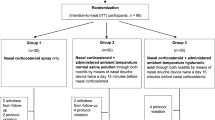Abstract
Nasal congestion is a cardinal symptom of allergic rhinitis (AR). It is associated with decreased quality of life and difficult to treat as perceived by the patients. The purpose of this study is to evaluate the mid-term objective and subjective outcomes of management of nasal congestion using intranasal steroid (INS) therapy or radiofrequency turbinoplasty (RFT) in patients with persistent AR who have mucosal hypertrophy of the inferior turbinate. Fifty-five adult patients with AR, who claimed nasal congestion refractory to oral antihistamine (desloratadine) therapy, were randomized to INS (mometasone furoate) or temperature-controlled RFT treatment groups. Outcomes were determined by active anterior rhinomanometry, visual analog scale (VAS), and rhinoconjunctivitis quality of life questionnaire (RQLQ) at least 12 months after treatment. The median total nasal resistance decreased from 0.49 ± 0.17 to 0.39 ± 0.12 Pa/cm3/s (p = 0.42), and from 0.51 ± 0.18 to 0.29 ± 0.07 Pa/cm3/s (p = 0.003) with INS and RFT, respectively. RFT provided a better reduction in the perception of congestion in VAS scores. RQLQ scores improved significantly in both groups 1 year after treatment (mean follow-up 14.2 months) (p < 0.05). No adverse reactions were encountered in either group. Nasal congestion refractory to antihistamine appears to be improved by INS at some point, while reduced significantly by RFT in objective and subjective parameters. Both options are also effective in increasing the quality of life in patients with AR. RFT might be a safe and effective treatment of option in AR compared with INS.



Similar content being viewed by others
References
Bousquet J, Khaltaev N, Cruz AA, Denburg J, Fokkens WJ et al (2008) Allergic rhinitis and its impact on asthma (ARIA) 2008 update. Allergy 63:S8–S160
Marple BF, Fornadley JA, Patel AA, Fineman SM, Fromer L, Krouse JH, Lanier BQ, Penna P (2007) American Academy of Otolaryngic Allergy Working Group on Allergic Rhinitis. Keys to successful management of patients with allergic rhinitis: focus on patient confidence, compliance, and satisfaction. Otolaryngol Head Neck Surg 136:S107–S124
Shedden A (2005) Impact of nasal congestion on quality of life and work productivity in allergic rhinitis: findings from a large online survey. Treat Respir Med 4:439–446
Nathan RA (2008) The pathophysiology, clinical impact, and management of nasal congestion in allergic rhinitis. Clin Ther 30:573–586
Berger G, Bernheim J, Ophir D (2007) Epithelial shedding of the inferior turbinate in perennial allergic and nonallergic rhinitis: a riddle to solve. Arch Otolaryngol Head Neck Surg 133:78–82
Wang DY, Raza R, Gordon BR (2004) Control of nasal obstruction in perennial allergic rhinitis. Curr Opin Allergy Clin Immunol 4:165–170
Sapci T, Sahin B, Karavus A et al (2003) Comparison of the effects of radiofrequency tissue ablation, CO2 laser ablation and partial turbinectomy applications on nasal mucociliary functions. Laryngoscope 113:514–519
Porter MW, Hales NW, Nease CJ et al (2006) Long-term results of inferior turbinate hypertrophy with radiofrequency treatment: a new standard of care? Laryngoscope 116:554–557
Willatt D (2009) The evidence for reducing inferior turbinates. Rhinology 47:227–236
Canonica GW, Tarentini F, Compalati E et al (2007) Efficacy of desloratadine in the treatment of allergic rhinitis: a meta-analysis of randomized, double-blind, controlled trials. Allergy 62:359–366
Gurevich F, Glass C, Davies M, Wei W, McCann J et al (2005) The effect of intranasal steroid budesonide on the congestion-related sleep disturbance and daytime somnolence in patients with perennial allergic rhinitis. Allergy Asthma Proc 26:268–274
Yilmaz M, Kemaloğlu YK, Baysal E, Tutar H (2006) Radiofrequency for inferior turbinate hypertrophy: could its long-term effect be predicted with a preoperative topical vasoconstrictor drop test? Am J Rhinol 20:32–35
Clement PA, Gordts F (2005) Standardisation Committee on Objective Assessment of the Nasal Airway, IRS, and ERS. Consensus report on acoustic rhinometry and rhinomanometry. Rhinology 43:169–179
Yuksel H, Yilmaz O, Alkan S, Degirmenci P, Kirmaz C (2009) Validity and reliability of Turkish version of rhinitis and mini-rhinitis quality of life questionnaires. Allergol Immunopathol 37:293–297
van Spronsen E, Ingels KJ, Jansen AH, Graamans K, Fokkens WJ (2008) Evidence-based recommendations regarding the differential diagnosis and assessment of nasal congestion: using the new GRADE system. Allergy 63:820–833
Berger WE, Nayak AS, Staudinger HW (2005) Mometasone furoate improves congestion in patients with moderate-to-severe seasonal allergic rhinitis. Ann Pharmacother 39:1984–1989
Berger G, Gass S, Ophir D (2006) The histopathology of the hypertrophic inferior turbinate. Arch Otolaryngol Head Neck Surg 132:588–594
Mori S, Fujieda S, Yamada T, Kimura Y, Takahashi N (2002) Long-term effect of submucous turbinectomy in patients with perennial allergic rhinitis. Laryngoscope 112:865–869
Lin HC, Lin PW, Su SY et al (2003) Radiofrequency for the treatment of allergic rhinitis refractory to medical therapy. Laryngoscope 113:673–678
Salib RJ, Harries PG, Nair SB, Howarth PH (2008) Mechanisms and mediators of nasal symptoms in non-allergic rhinitis. Clin Exp Allergy 38:393–404
Juniper EF, Thompson AK, Roberts JN (2002) Can the standard gamble and rating scale be used to measure quality of life in rhinoconjunctivitis? Comparison with the RQLQ and SF-36. Allergy 57:201–207
Conflict of interest
None of the authors have any conflict of interest.
Author information
Authors and Affiliations
Corresponding author
Rights and permissions
About this article
Cite this article
Gunhan, K., Unlu, H., Yuceturk, A.V. et al. Intranasal steroids or radiofrequency turbinoplasty in persistent allergic rhinitis: effects on quality of life and objective parameters. Eur Arch Otorhinolaryngol 268, 845–850 (2011). https://doi.org/10.1007/s00405-010-1462-1
Received:
Accepted:
Published:
Issue Date:
DOI: https://doi.org/10.1007/s00405-010-1462-1




